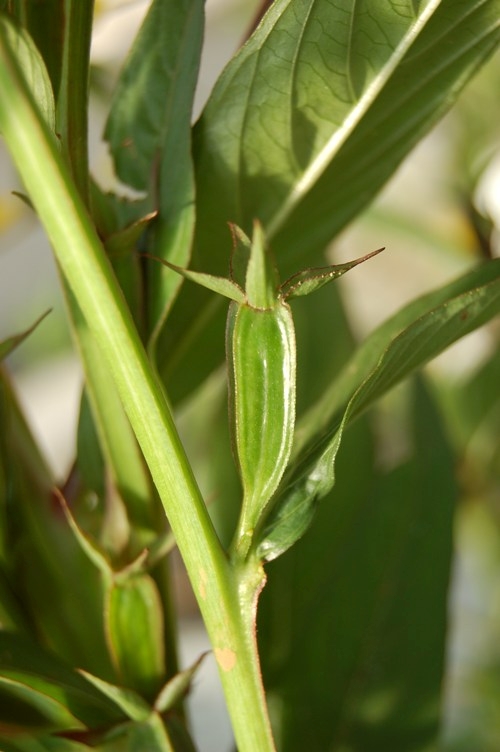- Author: Luis Espino
A new weed has been identified in California rice. Its name is winged primrose willow (WPW), and it is a weed in rice fields in the southern US. So far this weed has been identified only in fields near Richvale. The Butte County Ag Commissioner is working to make sure this weed doesn't spread to other areas. The UC Davis Rice Weed Science Project and UCCE is collecting information about its biology, possible impact and management.
Don't confuse WPW with other waterprimroses, similar weeds that are usually seen around rice fields and ditches and are prostrate. WPW habit is erect, the yellow flowers have 4 petals, and the stem has wings or membranes that run longitudinally. Unlike other waterprimroses, WPW can grow within flooded rice fields, which makes it more problematic.
Here's what WPW looks like in the field
Flowers have 4 petals
Cross section of stem, showing "wings"
Fruit
This is NOT WPW, this is the waterprimrose that we usually see around field borders, notice the prostrate habit
This is NOT WPW, common waterprimrose flower has 5 petals
If you suspect you have WPW in your field, call any of the UCCE Rice Advisors or your Ag Commissioner.
Photos by J. Eckert and L. Espino.
- Author: Luis Espino
Almost two weeks ago the California Rice Experiment Station (RES) had its annual field day. It was a great opportunity to see fist-hand the research going on at the station. The tour included a look at how RES breeders select rice varieties that promise good yield and quality and research couducted by RES and University of California scientists in the areas of insect, disease and weed management.
The field day is also a great opportunity to visit with growers and others working in the rice industry. If you missed it, plan on attending next year. The date is usually announced on the RES webpage (http://www.plantsciences.ucdavis.edu/ricestation/) and in UCCE rice newsletters.
Jim Erdman presenting the California Rice Industry Award

Peter Panton, recipient of the California Rice Industry Award

Larry Godfrey, UC Davis, presenting his insect research

Virgilio Andaya, RES breeder, giving an update on short grain varieties

Jeff Oster, RES plant pathologist, updating the tour about blast, stem rot and other diseases

Kent McKenzie, RES director, talking about the medium grain breeding program and other projects

Albert Fischer, UC Davis, giving his weed presentation

Tour trucks had a canopy this year!

- Author: Luis Espino
I visited a field a few weeks ago in the Woodland area. Older leaves showed discolored tips and margins, and necrotic spots. Leaf tips eventually turned brown and die.



The grower was worried it might have been blast, because of some of the lesions were elliptical and resembled blast lesions.

A leaf tissue analysis showed that boron levels were very high. Most likely the symptoms were caused by boron toxicity. Boron toxicity can be caused by use of water with high boron concentration or by excessive boron levels in the soil.
The UC manual "Rice Nutrient Management in California" mentions that boron toxicity in California is rare and usually occurs due to use of irrigation water with high contents of boron. To reduce the level of boron in the soil solution, use irrigation water with low boron content to leach boron form the root zone.
- Author: Luis Espino
Released August 29, 2011, by the National Agricultural Statistics Service (NASS), Agricultural Statistics Board, United States Department of Agriculture (USDA).
![ppt53.pptm [Recovered] ppt53.pptm [Recovered]](http://ucanr.org/blogs/riceblog/blogfiles/8403.jpg)
- Author: Luis Espino
Released August 15, 2011, by the National Agricultural Statistics Service (NASS), Agricultural Statistics Board, United States Department of Agriculture (USDA).




